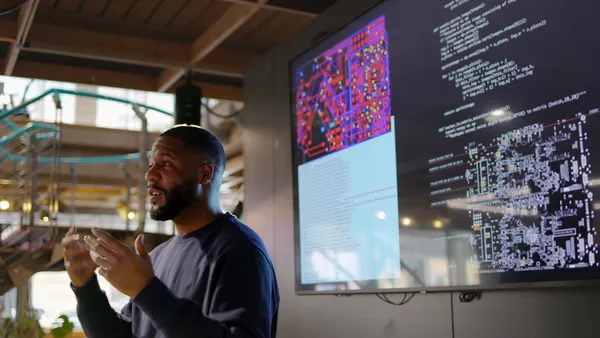PHILADELPHIA — What is computational thinking? How is it different from computer science? How do I measure it? A Monday afternoon session at this year's annual International Society for Technology in Education (ISTE) conference tackled these questions.
Hosted by ISTE Computer Science Advisor and Govern For America Co-Founder and CEO Octavia Abell and Dave Frye, senior director for computer science initiatives at the William and Ida Friday Institute for Educational Innovation at North Carolina State University, the conversation was geared toward how computational thinking fits across curriculum. As one attendee put it, the question isn't so much where you can find computational thinking as it is where can't you find it.
But before you can address that, you have to understand what computer science is and isn't, Abell noted, adding that it's connected to computer science but not the same thing.
Frye echoed this, saying that people often interchange the two when they mean to talk about the other one. He said:
- Computer science is the study of computers and algorithmic processes.
- Computational thinking is the thought processes involved in formulating problems and their solutions so they can be carried out by an information-processing agent. It's a process that involves formulating problems, organizing and analyzing data, representing data through abstractions, automating solutions, and testing and refining those solutions for efficiency.
It can also be thought of as four key components:
- Decomposition — breaking down a problem into parts.
- Pattern recognition — finding patterns or trends.
- Algorithms — developing steps to complete a task.
- Abstraction — generalizing trends into rules.
That's all fine, but how does the fit into curriculum?
There’s growing demand for computer science education policy, Abell said. In 2013, there were just over a dozen states with policies and now there are over 40. There are also more than 500,000 open computing jobs, with that number projected to hit 1.4 million by 2022, she added.
Additionally, there's demand for schools to build 21st century and workforce readiness skills in students, and to empower them to be creators and not consumers of digital media. Furthermore, schools and districts must now distinguish themselves in a competitive school choice environment.
But teaching computational thinking skills doesn't have to come at the expense of a well-rounded education, the speakers said. It can be applied to and found in a number of real-world situations, from music to engineering. Students encounter it in STEM and computer science as well as when they design things in a makerspace or study the media.
Reiterating again that it’s really a question of where don’t we see it, Abell whispered into the microphone, “It's silent because it’s everywhere.”
Circling back to the four components, you might see these examples:
- Decomposition: In English language arts, breaking down the analysis of a poem into meter, rhyme, imagery, structure, tone, diction and meaning.
- Pattern recognition: In social studies, identifying cycles in the rise and fall of a country’s economy.
- Algorithms: In a media literacy lesson, examining how algorithms affect dialogue and news feeds in social media.
- Abstraction: In environmental science, predicting the effects of removing a species from an ecosystem.
Computational thinking, the presenters noted, also plays a role in a number of standards frameworks, including:
- 2017 CSTA K-12 CS Standards
- 2018 ISTE CT Competencies
- 2016 ISTE Standards for Students
- 2014 NGSS Standards
- Common Core Standards for Mathematics
- ISTE/CSTA Standards for CS Educators (coming December)
Through these avenues, “instead of making this feel like an add-on, it can be part of the work you’re already doing,” Abell said. “The takeaway here is really that computational thinking is in elements you’re already using in your classroom.”













